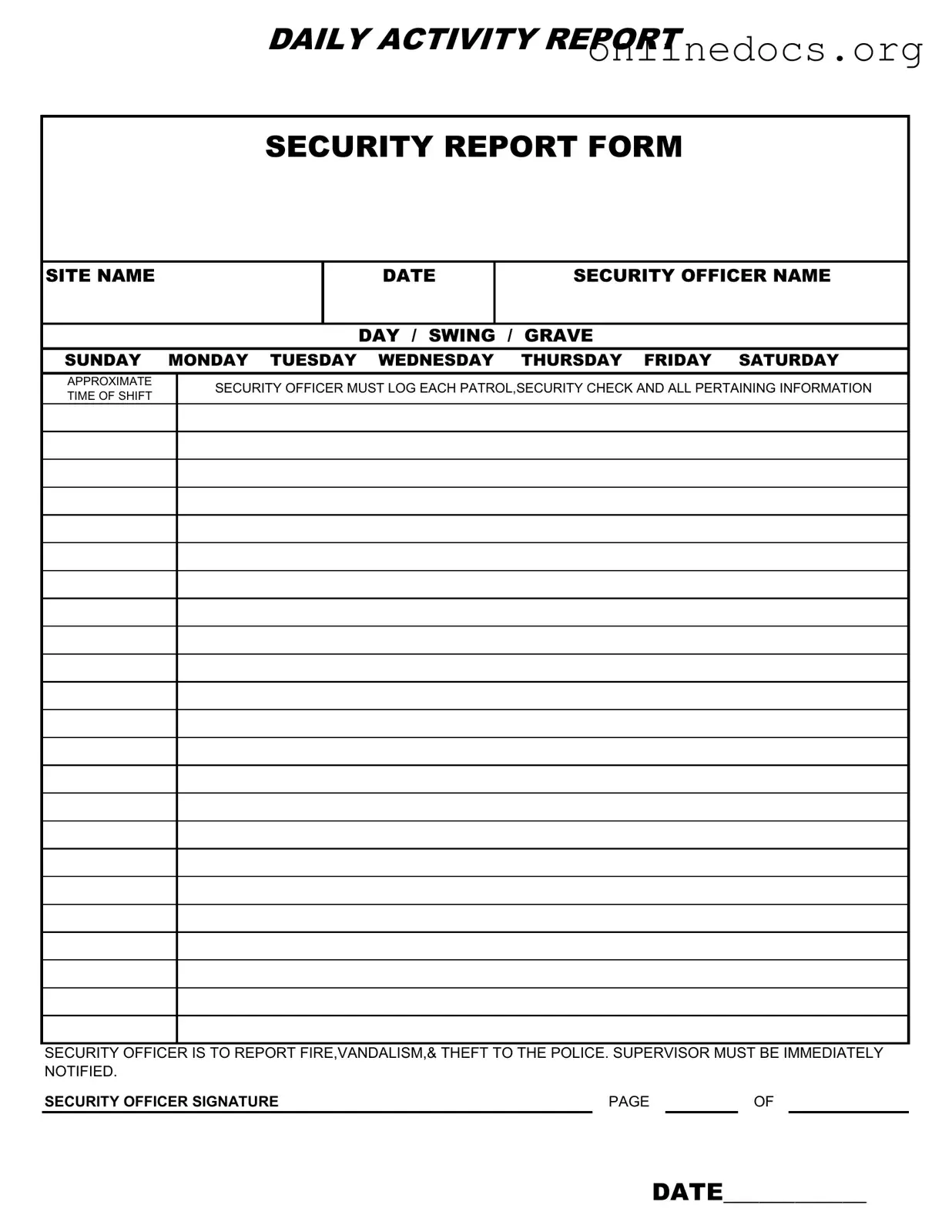The Incident Report Form serves a similar purpose to the Security Guard Daily Report. Both documents are used to record significant events and activities that occur during a specific timeframe. The Incident Report focuses on documenting specific incidents, such as accidents or security breaches, providing details like time, location, and individuals involved. This form may also require a narrative description, which enhances the context of the event. In contrast, the Security Guard Daily Report encompasses a broader range of activities, including routine patrols and checks, alongside incident reporting.
The Daily Log Sheet is another document that shares similarities with the Security Guard Daily Report. Both forms are used to track daily activities and occurrences. The Daily Log Sheet typically provides a structured format for recording time-stamped entries, which can include patrols, visitor logs, and maintenance issues. While the Security Guard Daily Report includes specific fields for incidents such as fire or theft, the Daily Log Sheet may focus more on general observations and operational tasks performed throughout the day.
The Shift Report is also akin to the Security Guard Daily Report. This document is often used by security personnel to summarize their shift's activities and any unusual occurrences. The Shift Report may include information about personnel on duty, notable events, and any issues that arose during the shift. Like the Security Guard Daily Report, it serves as a record for supervisors and can be used for future reference or investigations.
For those looking to formalize the sale of personal property, understanding the importance of a Bill of Sale form in Pennsylvania is crucial. This document not only acts as a legal record of the ownership transfer but can also help clarify any potential disputes down the line. To obtain a properly formatted form, resources such as legalformspdf.com can be invaluable, ensuring that all necessary elements are included for a valid transaction.
The Patrol Log is another relevant document that resembles the Security Guard Daily Report. Security officers use this log to document their patrol routes, times, and any observations made during their rounds. The Patrol Log focuses specifically on the details of the patrols, such as the areas covered and any incidents encountered. In contrast, the Security Guard Daily Report encompasses a wider scope, including various types of checks and overall daily activities.
The Daily Activity Report is similar in that it captures the overall activities of security personnel throughout the day. This document often includes a summary of tasks performed, incidents reported, and any communications with law enforcement or supervisors. While both reports aim to provide an overview of daily operations, the Daily Activity Report may be less detailed regarding specific incidents compared to the Security Guard Daily Report, which emphasizes incident documentation.
The Security Incident Log is another document that aligns with the Security Guard Daily Report. This log is specifically focused on recording incidents that require immediate attention, such as theft, vandalism, or disturbances. It often includes detailed accounts of each incident, including responses taken and follow-up actions. The Security Guard Daily Report, while also documenting incidents, covers a broader range of daily activities and checks performed by the security officer.
The Event Report is similar in function to the Security Guard Daily Report, particularly in contexts where security is provided for specific events. This document captures details about the event, including attendance, security measures implemented, and any incidents that occurred. While the Security Guard Daily Report provides a daily overview of activities, the Event Report focuses on the unique circumstances surrounding a particular event and the security measures taken.
The Visitor Log is another document that bears resemblance to the Security Guard Daily Report. This log is used to track individuals entering and exiting a facility. It typically includes the names of visitors, times of entry and exit, and the purpose of their visit. While the Visitor Log is more focused on access control, the Security Guard Daily Report includes visitor interactions as part of the broader range of daily security activities.
Finally, the Maintenance Report can be viewed as a document similar to the Security Guard Daily Report. This report is used to document maintenance issues observed during a security officer's shift, such as broken equipment or safety hazards. While the Security Guard Daily Report focuses on security-related activities, both documents serve to enhance overall facility safety and operational efficiency by ensuring that necessary information is recorded and communicated to the appropriate parties.
